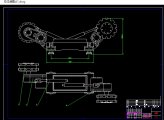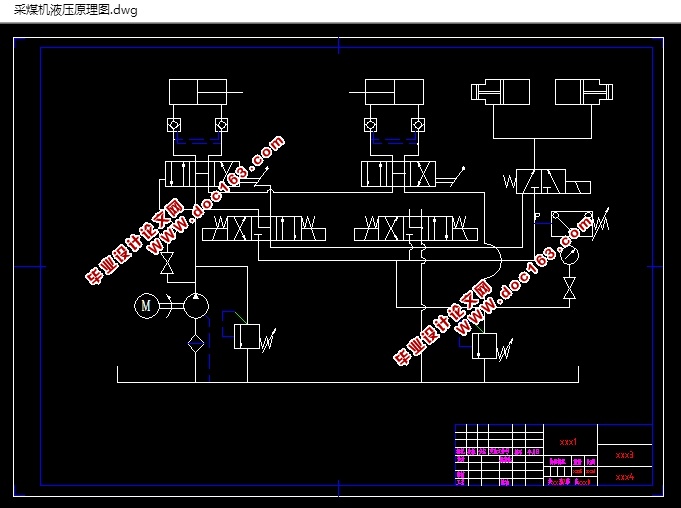大型滚筒式露天采煤机液压系统设计(含CAD图)

大型滚筒式露天采煤机液压系统设计(含CAD图)(论文说明书17000字,CAD图纸3张)
摘 要
本次设计中是以GTY400\900-3.3D电牵引滚筒采煤机为原型设计的,采煤机的液压系统,由牵引液压系统、截煤滚筒调高系统和破碎滚筒调高系统三部分组成。其牵引液压系统包括主油路系统、操作系统和保护系统。
采煤机的调高系统由截煤调高系统和破碎调高系统组成。 液压传动系统的设计是整机设计的一部分,它除了应符合主机动作循环和静动态性能等方面的要求外,还应当满足结构简单,工作安全可靠、效率高、寿命长、经济性好、使用维护方便等条件。
关键词: 采煤机摇臂 液压系统 相似原理
Abstract
This design is based on the GTY400\900-3.3D electric traction shearer as the prototype design, shearer hydraulic system, by the traction hydraulic system, the coal cutting drum height adjustment system and the broken drum height adjustment system three parts. The traction hydraulic system comprises a main oil path system, an operating system and a protection system.
Height adjusting system of shearer cutting coal by adjusting system and adjusting system composed of crushing. Design of hydraulic drive system is part of the overall design, it in addition to the requirements shall be in accordance with the action cycle of the host and static and dynamic performance and other aspects, should also be meet the simple structure, safe and reliable work, high efficiency, long service life, good economy, maintenance is convenient wait for a condition. [来源:http://www.doc163.com]
Key word: Shearer Rocker Hydraulic system Similar principles
设计要求
采煤机型号为MGTY400/900-3.3D电牵引采煤机,其主要技术参数为:
装机总功率:900KW
滚筒转速:32.7r/min
截割速度:3.1m/s
牵引速度:0-9-15m/s
牵引力:300-500KN
滚筒直径:1800mm
滚筒截深:800mm
按比例1:6设计采煤机模型。设计出的摇臂能带动滚筒旋转,完成切割。采用变频器,电动机,同步带动滚筒旋转。
2.2 截割部参数设计
2.2.1 截齿参数的确定
从煤岩的破碎机理,“核”理论:芯片厚度较小,刀具前刀面容易形成核,晶核的形成和能源消费增长的占50%,80% ~破碎能量;切削厚度增大,滚筒截割数少,能耗低。经大量井下运行研究证明:在现有刀具强度条件下,单位能耗较小的最佳切屑厚度在30~60mm,煤岩坚固性系数f大取小值,f小取大值。这里初步取d=40mm
[来源:http://Doc163.com]



目录
摘 要 1
Abstract 2
目录 3
1 绪论 5
1.1滚筒式采煤机简介 5
1.2电牵引采煤机发展概况 6
1.3本文主要内容 8
2 采煤机模型确定 9
[资料来源:http://www.doc163.com]
2.1 设计要求 9
2.2 截割部参数设计 9
2.3 电机系统的确定 12
2.4 同步带传动的设计计算 14
2.5 轴的设计与校核 17
2.6轴承的选择与校核 18
2.6 本章小节 20
3调高系统 22
3.1电器操作 22
3.2液压操作 24
3.2.1调高锁紧回路 24
3.2.2滚筒调高 24
3.2.3调高油路 26
3.4卸载回路 26
3.5调高油缸位置锁定 26
第4章 液压系统的设计 28
4.1 液压系统的确定 28
4.2 液压马达的选择 30
4.3 液压泵的选择 30
4.4 液压阀的选择 31
4.5滤油器的选择 33
4.6 液压缸设计计算 34
4.7油箱选型设计 39 [资料来源:Doc163.com]
4.8 本章小结 42
结论 43
致谢 44
参考文献 45
上一篇:孔内键槽对称度检测装置的检具设计(含CAD零件装配图,SolidWorks三维图)
下一篇:500kg液压挖掘机主铲工作机构与液压驱动系统设计(含CAD零件装配图)
